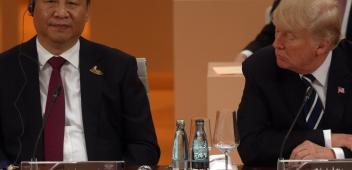Asia Power Snapshot: China and the United States in Southeast Asia
China is more influential than the United States in a number of measures in Southeast Asia and has increased its lead over the past five years.

- The United States has lost influence to China in Southeast Asia over the past five years in all four categories measured by the Asia Power Index: economic relationships, defence networks, diplomatic influence and cultural influence.
- The United States is more influential than China in two countries: the Philippines and Singapore. China’s influence is strongest in Laos, Cambodia and Myanmar.
- Compared to China, the United States still has much stronger defence relationships with countries in Southeast Asia. But China increased its lead over the United States in terms of economic relationships with Southeast Asia.
Overall influence of China and the United States in Southeast Asia
In the last five years, China has increased the overall margin of its influence compared to the United States in Southeast Asia. In 2018, China led the United States 52–48 for influence in the region. In 2022, this lead increased to 54–46.
Applying a new methodology to the data collected by the Lowy Institute for the Asia Power Index between 2018 and 2022, this report yields an in-depth analysis of the relative influence of the two countries in Southeast Asia.[1] These patterns of influence form part of the broad context in which Southeast Asian countries make their strategic choices.
Asia Power Index methodology measures influence across four categories: economic relationships, defence networks, diplomatic influence and cultural influence. A total of 100 points is available in each measure, with points assigned to the United States and China based on their relative performance (for further information, see Methodology).
In terms of individual countries, the United States remains more influential than China in the Philippines (leading 52–48) and Singapore (51–49). In 2018, it also led China in Thailand, but in 2022, China pulled ahead and now leads the United States 53–47. Beijing’s influence is strongest in Laos, Cambodia and Myanmar, where geographical proximity and relatively weak US engagement have enabled China to outstrip Washington’s influence by large margins.
In terms of measures of influence, China is more influential economically than the United States. But Washington’s defence networks continue to far outstrip those of Beijing. And while China has a considerable lead over the United States in diplomatic influence, reflecting its more comprehensive outreach to the region, Washington’s cultural influence, gained via media reach and people-to-people connections, remains higher than Beijing’s.
Trends in China–US influence in Southeast Asia
Since 2018, the United States has lost the most overall influence in Malaysia, slipping seven points. This was driven by China’s gains in defence networks and diplomatic influence. On defence networks, the change was a result of increased defence dialogues between China and Malaysia, and arms purchases, most notably Kuala Lumpur’s controversial purchase of Chinese Littoral Mission Ships.
The United States lost five points to China in both Brunei and Indonesia. In Brunei, this was driven by improvements in China’s economic relationships and defence networks, but was partially offset by a weakening of Beijing’s diplomatic influence (as measured by high-level diplomatic contact).
In Indonesia, the last five years have seen China make great strides in its economic relationships and defence networks. US diplomatic influence in Indonesia scores higher than in any other country in Southeast Asia, although still lower than that of China. This may reflect greater diplomatic effort by the United States in Indonesia over the last five years — a reflection of the country’s regional importance.
The sharp decrease in US influence in the Philippines since 2018 was caused by a decline in economic relationships. If US economic relationships continue to decline at the same rate over the next five years, Beijing’s overall influence will exceed Washington’s.
The decline in US economic relationships with the Philippines was evenly split across trade and investment indicators, with the United States losing ten points on trade relationships and nine points on investment relationships. The United States became relatively less important as a destination for Philippine exports. Goods and services exports from the Philippines to China increased from around US$12 billion in 2015 (the year of data captured in the 2018 Asia Power Index) to more than US$21 billion in 2021, while exports to the United States increased only modestly. And China now invests a lot more than the United States does in the Philippines — a situation that is the reverse of 2018 when the United States was a much bigger investor than China.
In Vietnam, a loss of US influence was driven by an uptick in the China–Vietnam defence relationship, reflecting a greater number of defence dialogues held with China than with the United States in 2021. Vietnam’s economic relationships did swing slightly towards the United States, possibly reflecting Hanoi’s success in attracting investment from US companies seeking to diversify away from China.
In Thailand, there was a decline in US influence across all categories. This tipped Thailand slightly towards China, whereas in 2018 it leaned towards the United States. In 2022, the decline in US cultural influence was mostly in the cultural projection category, driven by a sharp drop in online search interest in the United States from within Thailand.
In Singapore, US influence remained steady. A decline in US diplomatic influence was compensated for by an increase in US defence relationships.
Measures of influence
In 2022, US economic relationships were weaker than those of China in every country of Southeast Asia. The biggest disparity was in Laos, where the United States scored just eight points to China’s 92. By contrast, in neighbouring Cambodia, the United States scored 23 points to China’s 77, reflecting Cambodia’s greater ability to export goods to the United States. However, both Laos and Cambodia registered small decreases in China’s economic influence, suggesting that a surge in economic engagement with China driven by Belt and Road Initiative projects has tapered off, at least for now.
Defence networks are the United States’ greatest advantage in Southeast Asia. Its defence relationship is strongest with the Philippines, where it leads China by 88–12, reflecting the continued importance of the bilateral defence alliance for both countries. With Thailand — the other US treaty ally in Southeast Asia — the United States still enjoys a comfortable lead over China (79–21). The next most important defence relationship for Washington in the region is with Singapore, which is not a treaty ally but a significant defence partner for the United States. China’s most important defence relationship in the region is with Cambodia. But it is very much an outlier. In the few other countries where China leads on defence relationships, its advantage over the United States is much narrower. For example, in Laos, China only leads the United States in defence relationships by 52–48.
China’s diplomatic influence was greater than that of the United States in all countries in Southeast Asia in 2022. This reflects China’s greater focus on the region, including through its diplomatic networks, foreign minister-level engagement, and involvement in regional institutions such as the Association of Southeast Asian Nations (ASEAN), which was tracked as an individual indicator for this Snapshot.
In terms of cultural influence, the United States remains at a slight advantage. But in 2022, its score declined in every country except Vietnam. In this category, the United States has a strong lead over China in the Philippines and Vietnam, likely reflecting anti-China sentiment in both countries.
When it comes to cultural influence, the United States and China hold different advantages. The United States has influence through the reach of its news agencies, newspapers and broadcasters. China’s media influence is increasing but remains far below that of the United States in Southeast Asia. China, however, has greater people-to-people exchanges with Southeast Asia, as reflected in Asia Power Index data on diaspora and tourism connections.
Methodology
This Asia Power Snapshot adapts the methodology of the Lowy Institute Asia Power Index, an analytical tool developed by Lowy Institute Research Director Hervé Lemahieu. The Asia Power Index measures the comprehensive power of 26 countries based on a weighting of 133 indicators across eight measures. Further information about the Asia Power Index methodology is available here.
The Asia Power Snapshot measures the influence of the United States and China in the ten countries of the Association of Southeast Asian Nations (ASEAN). The Snapshot is based on 42 indicators across four measures and does not include the resource-based determinants of national power (military capability, economic capability, future resources and resilience). This is because these measures cannot be disaggregated to a sub-regional level. Several indicators used in the Asia Power Index were excluded as they were not directly relevant to influence in Southeast Asia, and in some cases, new indicators were inserted.
Scaled scores
For each indicator, a score of 100 is assigned for influence in each constituent country of Southeast Asia, plus a score of 100 for Southeast Asia as a whole. Each set of 100 points is divided between China and the United States according to the ratio of their relevant value in that indicator. The score for Southeast Asia as a whole represents a weighted average of the individual country scores.
For example, over a ten-year period, China invested approximately US$163.55 billion in Southeast Asia, while the United States invested about US$105.80 billion. As US investment accounted for around 39 per cent of the total from both countries, and Chinese investment roughly 61 per cent, they were assigned scores of 39 and 61 respectively for this indicator.
e.g.

Weightings
In compiling aggregate scores for each measure, and for overall influence in Southeast Asia, we have adopted the weightings used in the Asia Power Index, which reflect the dimensions of power considered most advantageous to countries given the current geopolitical landscape of the region.
| Measure | |
|---|---|
| Economic Relationships | 33.33% |
| Defence Networks | 22.22% |
| Diplomatic Influence | 22.22% |
| Cultural Influence | 22.22% |
Annex: data tables
Excel sheets formatted into a single PDF document can be downloaded here:
Note
- This research defines Southeast Asia as the ten countries of the Association of Southeast Asian Nations (ASEAN) — Brunei, Cambodia, Indonesia, Laos, Malaysia, Myanmar, the Philippines, Singapore, Thailand and Vietnam.


